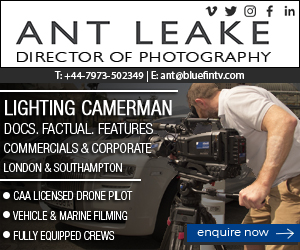Broadcast News
07/06/2013
Squinting Through The Industry’s Glass Eye (Pt 1)

Prime suspects: George Jarrett talks to the lens manufacturers about chip sizes and the turn again to anamorphic lenses for some ‘personality’ in digital imaging. And how significant is the technology alliance between Cooke and Angénieux?
The one product area that has been impervious to any downturn in recent years is the industry’s glass eye – lenses.
The booming market for digital cameras is the major reason, but that also introduces new challenges based around the look of any content, the sensors used by the various camera manufacturers and a lack of awareness amongst users. Just ask why there is a resurgence of interest in anamorphic lenses, and look closely at the size and packing of the pixels in the sensor in your camera.
To discuss the market and its problems and trends I spoke principally to Richard Schleuning, national sales manager for Zeiss in the US, to Cooke chairman and owner Les Zellan, and to Larry Thorpe from Canon. New products of interest also came from Angenieux and Fujinon.
The good glass, bad glass issue
Zeiss introduced a third line of compact prime cine lenses for the entry-level market.
“This is a brand new business for us, and it is fairly high volume in addition to the master primes and ultra primes,” Schleuning said.
“The demand for cine style lenses throughout the industry is remarkable right now.”
He produced a new compact zoom (28-80) and a master anamorphic, and said: “We are telling customers that when they consider using lenses on 4K and higher resolution cameras that they really need to understand how manufacturers arrive at high resolution. There are very different paths they can take.
“For example, take Sony and its F65. It achieves high resolution by packing more pixels into the S35 sensor. In fact, the pixel size is four microns. This is the same as the D-800 for still photography,” he added.
“Because we straddle the still photography and the motion picture capture worlds we know that fine resolution separates good glass from bad glass very quickly. That very small pixel size demands a very high-resolution lens, otherwise you are wasting your investment in a good quality camera.”
Legacy PL mount lenses might be deployed, and they would cover the image circle size, but whether or not they can resolve the very fine detail of that sensor is a good question. The Canon DSLR has a different form factor, and Schleuning feels it is vital for users to know the differences.
“Canon’s pixel size is 7 microns, so it achieves 4K res by going with the 24 X 36 chip, which is roughly twice the size of the F65 chip,” he said. “So for a filmmaker you have to consider which lenses to match with these working cameras.”
So with Canon you need a lens that covers a 24 x 36 chip and with the F65 you require higher quality optics.
“Matching the right lens with the right camera is very critical,” said Schleuning. “Our new lenses, particularly the compact zooms, are the only cine style zooms in the world that cover the 24 X 36 chip. We believe that within the working life of these lenses (10-15 years) that sensors are going to continue getting bigger.
“This trend is starting to evolve. Red is upgrading cameras right now with the new Dragon sensor, which can achieve 6K res with a slightly larger sensor size. The pixel size of 5 microns is not as small as Sony uses, but Red gets 6K through the bigger chip,” he added.
“We believe that the diagonal on that chip is 34.5mm, so there will be a lot of legacy PL mount lenses that won’t cover that chip at 6K.”
There is a lot of pressure from studio producers to lower the cost of equipment, which is one big reason for the Zeiss compact prime range. Producers want cinematographers to create high image quality, but with much lower equipment and rental budgets.
“They may be going with a full digital cinema package, and a lot of guys are opting for a DSLR and other entry-level cameras because they have a price point that these production budgets can now match,” said Schleuning. “They need lenses to match that, in fact the entire accessory package to match that camera. Our lenses have the same barrel dimensions, so swap outs between focal lengths are still easy to do. We wanted to make sure that users still have the control of focus and aperture, but in a lens that has an affordable price. Camera technology is changing so quickly it is hard to make the right choice.”
Anamorphic funkiness
Les Zellan pointed at one issue: what if you want to shoot anamorphic in the digital age?
“If you shoot on film there is something to keep your eye occupied – intrinsic interest because the grain is always changing. If I shoot the same elements with a digital camera there is nothing there. It is just a log, and there is nothing going on,” he said.
“What we see, as digital cameras get better and better, is a rush of people saying: ‘I love the Cooke look; I love the Cooke lenses, but can I get an anamorphic option? It introduces a little character, a little personality into what otherwise could become a pretty boring shot,” he added. “The resurgence of interest in shooting with anamorphic lenses is not because people care about using every pixel. They don’t. It is because of the technical term ‘anamorphic funkiness’.”
Read the article in the online edition of Regional Film & Video here.
(IT/MH)
The one product area that has been impervious to any downturn in recent years is the industry’s glass eye – lenses.
The booming market for digital cameras is the major reason, but that also introduces new challenges based around the look of any content, the sensors used by the various camera manufacturers and a lack of awareness amongst users. Just ask why there is a resurgence of interest in anamorphic lenses, and look closely at the size and packing of the pixels in the sensor in your camera.
To discuss the market and its problems and trends I spoke principally to Richard Schleuning, national sales manager for Zeiss in the US, to Cooke chairman and owner Les Zellan, and to Larry Thorpe from Canon. New products of interest also came from Angenieux and Fujinon.
The good glass, bad glass issue
Zeiss introduced a third line of compact prime cine lenses for the entry-level market.
“This is a brand new business for us, and it is fairly high volume in addition to the master primes and ultra primes,” Schleuning said.
“The demand for cine style lenses throughout the industry is remarkable right now.”
He produced a new compact zoom (28-80) and a master anamorphic, and said: “We are telling customers that when they consider using lenses on 4K and higher resolution cameras that they really need to understand how manufacturers arrive at high resolution. There are very different paths they can take.
“For example, take Sony and its F65. It achieves high resolution by packing more pixels into the S35 sensor. In fact, the pixel size is four microns. This is the same as the D-800 for still photography,” he added.
“Because we straddle the still photography and the motion picture capture worlds we know that fine resolution separates good glass from bad glass very quickly. That very small pixel size demands a very high-resolution lens, otherwise you are wasting your investment in a good quality camera.”
Legacy PL mount lenses might be deployed, and they would cover the image circle size, but whether or not they can resolve the very fine detail of that sensor is a good question. The Canon DSLR has a different form factor, and Schleuning feels it is vital for users to know the differences.
“Canon’s pixel size is 7 microns, so it achieves 4K res by going with the 24 X 36 chip, which is roughly twice the size of the F65 chip,” he said. “So for a filmmaker you have to consider which lenses to match with these working cameras.”
So with Canon you need a lens that covers a 24 x 36 chip and with the F65 you require higher quality optics.
“Matching the right lens with the right camera is very critical,” said Schleuning. “Our new lenses, particularly the compact zooms, are the only cine style zooms in the world that cover the 24 X 36 chip. We believe that within the working life of these lenses (10-15 years) that sensors are going to continue getting bigger.
“This trend is starting to evolve. Red is upgrading cameras right now with the new Dragon sensor, which can achieve 6K res with a slightly larger sensor size. The pixel size of 5 microns is not as small as Sony uses, but Red gets 6K through the bigger chip,” he added.
“We believe that the diagonal on that chip is 34.5mm, so there will be a lot of legacy PL mount lenses that won’t cover that chip at 6K.”
There is a lot of pressure from studio producers to lower the cost of equipment, which is one big reason for the Zeiss compact prime range. Producers want cinematographers to create high image quality, but with much lower equipment and rental budgets.
“They may be going with a full digital cinema package, and a lot of guys are opting for a DSLR and other entry-level cameras because they have a price point that these production budgets can now match,” said Schleuning. “They need lenses to match that, in fact the entire accessory package to match that camera. Our lenses have the same barrel dimensions, so swap outs between focal lengths are still easy to do. We wanted to make sure that users still have the control of focus and aperture, but in a lens that has an affordable price. Camera technology is changing so quickly it is hard to make the right choice.”
Anamorphic funkiness
Les Zellan pointed at one issue: what if you want to shoot anamorphic in the digital age?
“If you shoot on film there is something to keep your eye occupied – intrinsic interest because the grain is always changing. If I shoot the same elements with a digital camera there is nothing there. It is just a log, and there is nothing going on,” he said.
“What we see, as digital cameras get better and better, is a rush of people saying: ‘I love the Cooke look; I love the Cooke lenses, but can I get an anamorphic option? It introduces a little character, a little personality into what otherwise could become a pretty boring shot,” he added. “The resurgence of interest in shooting with anamorphic lenses is not because people care about using every pixel. They don’t. It is because of the technical term ‘anamorphic funkiness’.”
Read the article in the online edition of Regional Film & Video here.
(IT/MH)
Top Related Stories
Click here for the latest broadcast news stories.
23/02/2016
New Sigma Lens Mount Converter Expands High-Performance Lens Options
The Sigma Corporation of America has announced the release of its new high-performance Sigma Global Vision lens converter – the Mount Converter MC 11
New Sigma Lens Mount Converter Expands High-Performance Lens Options
The Sigma Corporation of America has announced the release of its new high-performance Sigma Global Vision lens converter – the Mount Converter MC 11
21/04/2004
Canon introduces two new HD lenses at NAB
Recognising the rapid expansion of HD camera system options from multiple manufacturers, Canon has unveiled two new HD studio lenses, the DIGISUPER 22
Canon introduces two new HD lenses at NAB
Recognising the rapid expansion of HD camera system options from multiple manufacturers, Canon has unveiled two new HD studio lenses, the DIGISUPER 22
05/04/2019
Angénieux To Preview New Book At NAB
Angénieux is set to preview its new 270-page book at NAB, chronicling the company's rise since its inception in 1935. There will be both a French and
Angénieux To Preview New Book At NAB
Angénieux is set to preview its new 270-page book at NAB, chronicling the company's rise since its inception in 1935. There will be both a French and
29/01/2019
Cooke Optics To Unveil Anamorphic/i Full Frame Plus Lens
Cooke Optics is to present not only a standard Anamorphic/i Full Frame Plus lens, but also - for the first time anywhere – an Anamorphic/i Full Frame
Cooke Optics To Unveil Anamorphic/i Full Frame Plus Lens
Cooke Optics is to present not only a standard Anamorphic/i Full Frame Plus lens, but also - for the first time anywhere – an Anamorphic/i Full Frame
09/11/2018
Cooke Adds 35mm-140mm Zoom Lens To Anamorphic/i SF Family
Cooke Optics has announced the addition of a 35mm-140mm zoom lens to its Anamorphic/i SF family, due to the demand of cinematographers around the worl
Cooke Adds 35mm-140mm Zoom Lens To Anamorphic/i SF Family
Cooke Optics has announced the addition of a 35mm-140mm zoom lens to its Anamorphic/i SF family, due to the demand of cinematographers around the worl
10/09/2018
Cooke Optics To Expand Anamorphic/i Lens Family
Cooke Optics is expanding its Cooke Anamorphic/i lens family with the introduction of a new 50mm focal length for the new Anamorphic/i Full Frame Plus
Cooke Optics To Expand Anamorphic/i Lens Family
Cooke Optics is expanding its Cooke Anamorphic/i lens family with the introduction of a new 50mm focal length for the new Anamorphic/i Full Frame Plus
12/10/2017
Cooke Anamorphic/i SF Lens Used On Production
Cooke Optics' Anamorphic/i SF lenses have been used on the recent production of Mark Felt: The Man Who Brought Down The White House, it has been revea
Cooke Anamorphic/i SF Lens Used On Production
Cooke Optics' Anamorphic/i SF lenses have been used on the recent production of Mark Felt: The Man Who Brought Down The White House, it has been revea
16/04/2013
ARRI Announces Master Anamorphic Lens Shipping
At last week's NAB Show in Las Vegas, ARRI announced the first three focal lengths (35 mm, 50 mm and 75 mm) of the ARRI/ZEISS Master Anamorphic lens s
ARRI Announces Master Anamorphic Lens Shipping
At last week's NAB Show in Las Vegas, ARRI announced the first three focal lengths (35 mm, 50 mm and 75 mm) of the ARRI/ZEISS Master Anamorphic lens s
12/04/2018
Few Lens Optics For Decades, Then Came The Large Digital Sensors
As software takes control of virtually every production and delivery function, cameras and lenses have reached the stage of looking magnificent as the
Few Lens Optics For Decades, Then Came The Large Digital Sensors
As software takes control of virtually every production and delivery function, cameras and lenses have reached the stage of looking magnificent as the
27/10/2017
Agile Remote Cameras Launches New PTZ Cameras & Controller
Agile Remote Cameras has announced the launch of two new PTZ cameras, each with a unique modular design, plus a desktop camera controller. The ARC360
Agile Remote Cameras Launches New PTZ Cameras & Controller
Agile Remote Cameras has announced the launch of two new PTZ cameras, each with a unique modular design, plus a desktop camera controller. The ARC360
06/09/2006
BBC Outside Broadcasts’ Special Cameras Team Pioneers HD Onboard Cameras
BBC Outside Broadcasts Special Cameras team recently pioneered HD onboard camera systems for the first time at Goodwood Revival Meeting. The meeting h
BBC Outside Broadcasts’ Special Cameras Team Pioneers HD Onboard Cameras
BBC Outside Broadcasts Special Cameras team recently pioneered HD onboard camera systems for the first time at Goodwood Revival Meeting. The meeting h
07/06/2013
Squinting Through The Industry's Glass Eye (Pt 2)
Someone looking at the various new anamorphic lenses at the show had said to Zellan that perfection is really over rated. “As soon as we get a perfect
Squinting Through The Industry's Glass Eye (Pt 2)
Someone looking at the various new anamorphic lenses at the show had said to Zellan that perfection is really over rated. “As soon as we get a perfect
15/06/2015
ARRI Announces A New Super-Wide Anamorphic Zoom
The new ARRI Anamorphic Ultra Wide Zoom AUWZ 19-36/T4.2 is a unique lens that perfectly complements the ARRI/ZEISS Master Anamorphic lenses by extendi
ARRI Announces A New Super-Wide Anamorphic Zoom
The new ARRI Anamorphic Ultra Wide Zoom AUWZ 19-36/T4.2 is a unique lens that perfectly complements the ARRI/ZEISS Master Anamorphic lenses by extendi
26/11/2021
Samyang Launches New XEEN Premium Lenses
Samyang has launched the new XEEN Premium lenses. Exclusively distributed in the UK and Ireland by Holdan, the XEEN Anamorphic 50mm T2.3 and XEEN Meis
Samyang Launches New XEEN Premium Lenses
Samyang has launched the new XEEN Premium lenses. Exclusively distributed in the UK and Ireland by Holdan, the XEEN Anamorphic 50mm T2.3 and XEEN Meis
13/09/2016
Angénieux Unveils New Optimo Lens
Making its European debut at IBC, Angénieux presented its new Optimo 44-440 A2S – the latest addition to its Optimo anamorphic 2x Squeeze series. The
Angénieux Unveils New Optimo Lens
Making its European debut at IBC, Angénieux presented its new Optimo 44-440 A2S – the latest addition to its Optimo anamorphic 2x Squeeze series. The















